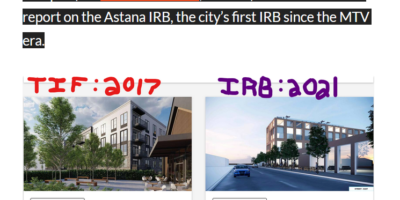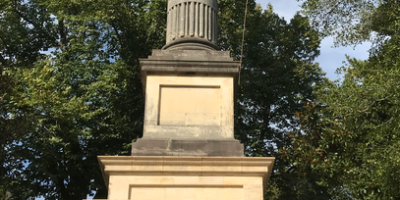Big Brother, can you spare a trolley?
“It’s a very cool thing!”
Mayor Jim Newberry
If you want to see the nexus between spend-happy government, liberal urban boosterism, and misplaced priorities, look no further than COLT, the newest addition to the Lexington public transit bus fleet: two fake trolley cars and three hybrid fake trolley cars patrolling the inner downtown between Transy and UK from 11:30-2:00 weekdays and from 6:00-1:00 or 3:00 A.M. Thursdays-Saturdays.
COLT is what you get when too many people go to too many cities and return home, raging, with too many good ideas and all heck to pay. Downtown development? Check. Feel good public transportation? Check. Strong whiffs of environmentalism? Check. Public/private partnerships? Check. Grant funding? Check. Old-money nostalgia? Check. The project is only just short of scoring a perfect 100 on the Richard Florida Creative Class Solutions scale.
So why the hell doesn’t it work?
We here at NoC have been pondering this question in earnest for some time. We’re still preparing our final report, but we thought we’d share some ideas not yet excised from our working drafts.
The COLT premise
The COLT system is designed to bring in the sort of new-age knowledge economy urban worker/player that 43% of U.S. cities are screaming for right now. This becomes obvious with a brief glance at where and when the COLT lines run. The north/south running COLT Green Line might be better named the Education Pays (Us) Line. It literally begins and ends at the edges of UK and Transy, which would be great if both schools didn’t clear out for three months each June.
The east/west running Blue Line (blue…original) is not much better in its single-constituency-mindedness. It should be renamed the Convention Guest Line. After getting picked up near Broadway and Vine, lucky hotel visitors and conventioneers get to travel down lovely Vine Street before turning around at Thoroughbred Park and coming back down Main Street (future franchise home of CVS). It’s kind of like a float on a lazy river, only its shorter, hotter, and slower.
The COLT schedule
COLT is kind of miraculous in a way. It created a system of public transportation that completely sidesteps the city’s poorly served transportation customers—the urban working poor, the working class, and comfortable but conscientious suburbanites who use it to leave for work in the morning and again at night on their return. Once again channeling Creative Class/Knowledge Economy needs, City Fathers decided that running a trolley during lunch and at drinking hours would somehow inspire people to….do what exactly? It isn’t clear.
COLT leaders designed a compact trolley system that serves the few, ignores the many, and caters to the needs of the city’s leisure class over the needs of its laborers. The city now provides a service that, despite public image-building, wasn’t wanted or needed by the group it was intended for in the first place, and that simultaneously insults the many Lexingtonians who toil going through the city’s poorly routed and funded city bus system.
Problem: Buses are slow; walking and biking are not
Even assuming that, say, a UK employee really, really wanted to hit the downtown shops during lunch hour, or a lawyer at the courthouse wanted to grab a bite to eat at Gumbo Ya Ya’s on Main Street, why grab a trolley to do so? The trolleys take about 20 minutes, on average, to complete their routes. With two trolleys on each line, trolleys arrive at and depart from their stops every ten minutes. Thing is, in ten minutes that UK employee could already be at the downtown pasture. By the time the trolley might catch up to them, any UK diners jonesing for Sunrise Bakery or Sam’s Hot Dogs or Sidebar would most likely be there already, or at least be close.
But that’s a good scenario. The lawyer working at the courthouse is even more inefficient if s/he tries to use the trolley. The Green/Education Pays line goes north/south and is of no use, while the closest stop for the Convention Centre line is Main Street, which travels west, away from Ya Ya’s. This busy lawyer, if s/he were to use the “convenience” of the trolley would be considerably late getting back to work: the line would have to travel around Triangle Park, pass the 6 or 7 red lights on Vine Street and make the turn back onto Main before exiting before Rose/Elm Tree at Ya Ya’s. This could take between 15 and 25 minutes to ride, or it could simply be a pleasant ten-minute walk.
And if that lawyer or UK worker had a bike, well, get out. No contest. Bikes smash COLTs. In a city context, they are infinitely more efficient, though not necessarily safe. But that’s another subject.
Is it environmentally friendly if nobody uses it?
This may seem like sand in the face here, but we’ve got to ask it. The COLT system has sold itself as an environmentally friendly project.
Conclusion
These, of course, are just some draft points. We offer them because we hold little hope that the buses will be discontinued before out of town WEGers (their real audience in all this) leave the state in late September. So we want to offer our appraisal of the problems inherent to the COLT lines. To repeat: they engage a mostly disengaged and self-centered audience (the “Creative Class”); they do so at the expense of Lexington citizens scattered in neighborhoods near and far who actually use the bus system and would like to see it work better; they are slow, inefficient and environmentally nonsensical.




Leave a Reply